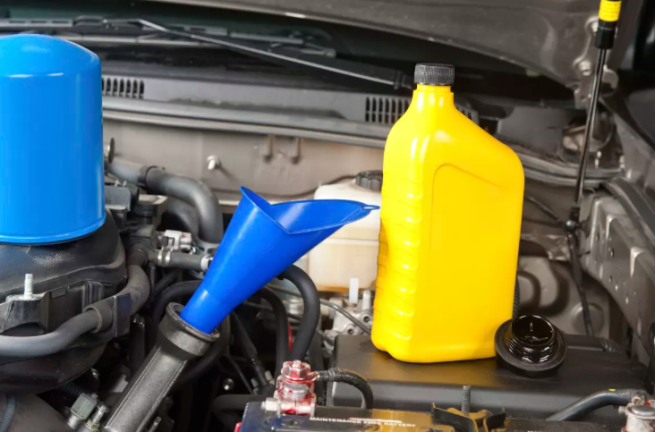
As long as there have been vehicles for sale, there’s been the used vs new vehicles debate.






Happy Holidays from Auction Direct USA



Most major oil brands market motor oil made specifically for engines that have more than 75,000 miles of wear, claiming that additives help reduce engine wear and provide anti-aging benefits. They are often a blend of synthetic and petroleum-based oils, and they typically cost at least a couple of dollars more per quart than conventional oils. But are they worth the extra dough?
Some oils may be more beneficial than others because they contain conditioners purported to rejuvenate seals to prevent or stop oil leaks, a common ailment in engines with high mileage.
Internal seals and gaskets become brittle and shrink as they age, allowing oil to seep by. Sometimes this becomes visible as streaks of oil on lower engine parts or oil stains on a garage floor or driveway. When valve-guide seals wear out, motor oil can leak into combustion chambers and the engine will literally start burning oil. With small leaks, blue smoke from burning oil may not be visible from the exhaust, but your oil level will probably drop below the full mark on a regular basis.
The seal conditioners found in some high-mileage motor oils may reduce or eliminate small leaks and seepage by rejuvenating seals to their original size and shape. If an engine isn’t burning or leaking oil, or if it uses, say, less than a quart over 6,000 miles or so, switching to high-mileage oil may not be worth the extra cost for you.
It’s really a judgment call if you should pay more for high-performance oil when your vehicle has 100,000 miles on it but is using little or no motor oil. High-mileage motor oil doesn’t hurt and it could prevent leaks from starting. Most vehicle manufacturers would say it’s normal for an engine to consume some oil between oil changes.
In addition to having seal conditioners, high-mileage oils usually boast more detergents designed to clean out sludge inside the engine, plus other additives meant to reduce wear on moving parts. Every motor oil, though, makes similar claims that it does great things inside an engine.
Some mechanics recommend switching to a thicker (higher viscosity) oil — such as 10W-30 full synthetic oil instead of 5W-20 full synthetic — or using oil additives to stop leaks. Thicker oil makes an engine harder to start in cold weather, reduces oil circulation around the engine and increases oil pressure, which means there will be more pressure trying to push the motor oil past seals and gaskets.

Whether you spot a puddle under your car or just a few drops, there are several possible culprits, and color alone might not explain what it is. How can you figure it out? To be sure, you’ll need to pinpoint where it’s coming from using your eyes and your nose.
Engine oil can be amber (if it’s fresh), brown or — if it hasn’t been changed for 10,000 miles — black, and it will leave slickness on your fingers that’s hard to wipe off. Oil can leak from gaskets and seals on the front or rear of an engine, from valve covers or from the oil pan underneath, so there are several possible sources of an oil leak.
Transmission fluid is usually reddish and slick, though some come in other colors and can be thicker or thinner than engine oil. If you suspect a transmission fluid leak, consult your owner’s manual to see how to check the fluid level. If you can get a clear look at the transmission, check for leaks around the seals or gaskets.
Power-steering fluid is usually reddish, and on some vehicles it’ll be the same fluid that goes into the transmission. Check the fluid level in the power-steering reservoir and look for leaks in the reservoir and the hoses coming from it.
Engine coolant can be green, yellow, pink or another color, so check your coolant overflow tank to see what’s in your radiator. Is the overflow tank empty? Maybe you’ve found your problem. Coolant usually feels like slimy water and has a sweet smell. Leaks can come from the overflow tank, the radiator, the water pump, coolant hoses and elsewhere. For your own safety, wait until your engine is cold before opening the radiator cap.
Brake fluid can be light brown or even clear when new, but it typically darkens as it ages. It’s also slippery — and vital to stopping your car. That’s a good reason to treat a brake fluid leak as an emergency. Check the brake fluid level in the reservoir (usually near the firewall on the driver’s side) and see if you can see any leaks there. The fluid gets pumped through brake lines to the wheels, so leaks could be much further downstream and out of sight.
A few drops of fluid on your driveway isn’t reason to panic, especially on an older car. Seepage and minor leaks are par for the course on vehicles with several years and thousands of miles on the clock. That said, any leak should be a wake-up call to keep an eye on things before it becomes a gusher, and to regularly check fluid levels (all of them) to make sure you aren’t running low anywhere.
If you’re losing sleep worrying about a fluid leak, ask your dealership or local repair shop to take a look. Draining fluids can be a drain on your wallet, but the earlier they’re caught, the better.